
The Poales are a large order of flowering plants in the monocotyledons, and includes families of plants such as the grasses, bromeliads, rushes and sedges. Sixteen plant families are currently recognized by botanists to be part of Poales.
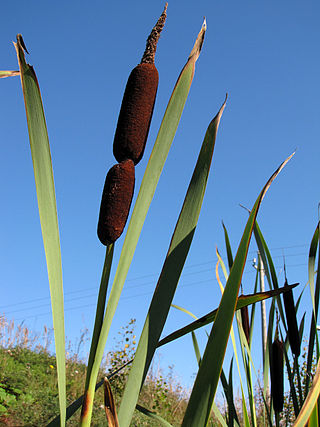
The Typhaceae are a family of flowering plants, sometimes called the cattail family. The botanical name for the family has been recognized by most taxonomists.

Petrosaviaceae is a family of flowering plants belonging to a monotypic order, Petrosaviales. Petrosaviales are monocots, and are grouped within the lilioid monocots. Petrosaviales is a very small order composed of one family, two genera and four species accepted in 2016. Some species are photosynthetic (Japonolirion) and others are rare, leafless, chlorophyllous, mycoheterotrophic plants (Petrosavia). The family is found in low-light montane rainforests in Japan, China, Southeast Asia and Borneo. They are characterised by having bracteate racemes, pedicellate flowers, six persistent tepals, septal nectaries, three almost-distinct carpels, simultaneous microsporogenesis, monosulcate pollen, and follicular fruit.

Nartheciaceae is a family of flowering plants. The APG III system places it in the order Dioscoreales, in the clade monocots. As circumscribed by APG IV (2016) it includes 35 species of herbaceous plants in the following five genera:

The Strelitziaceae comprise a family of monocotyledonous flowering plants, very similar in appearance and growth habit to members of the related families Heliconiaceae and Musaceae. The three genera with seven species of Strelitziaceae have been included in Musaceae in some classifications, but are generally recognized as a separate family in more recent treatments such as the APG II system (2003). The APG II system assigns the Strelitziaceae to the order Zingiberales in the commelinid clade.

Plumbaginaceae is a family of flowering plants, with a cosmopolitan distribution. The family is sometimes referred to as the leadwort family or the plumbago family.
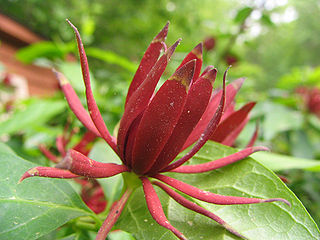
The Calycanthaceae are a small family of flowering plants in the order Laurales. The family contains three genera and only 10 known species, restricted to warm temperate and tropical regions:
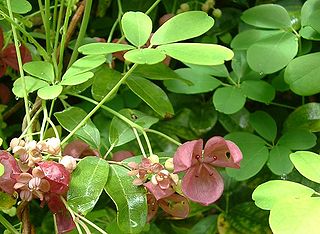
Lardizabalaceae is a family of flowering plants.

Juncaginaceae is a family of flowering plants, recognized by most taxonomists for the past few decades. It is also known as the arrowgrass family. It includes 3 genera with a total of 34 known species.

Chloranthaceae is a family of flowering plants (angiosperms), the only family in the order Chloranthales. It is not closely related to any other family of flowering plants, and is among the early-diverging lineages in the angiosperms. They are woody or weakly woody plants occurring in Southeast Asia, the Pacific, Madagascar, Central and South America, and the West Indies. The family consists of four extant genera, totalling about 77 known species according to Christenhusz and Byng in 2016. Some species are used in traditional medicine. The type genus is Chloranthus. The fossil record of the family, mostly represented by pollen such as Clavatipollenites, extends back to the dawn of the history of flowering plants in the Early Cretaceous, and has been found on all continents.

Trimeniaceae is a family of flowering plants recognized by most taxonomists, at least for the past several decades. It is a small family of one genus, Trimenia, with eight known species of woody plants, bearing essential oils. The family is subtropical to tropical and found in Southeast Asia, eastern Australia and on several Pacific Islands.
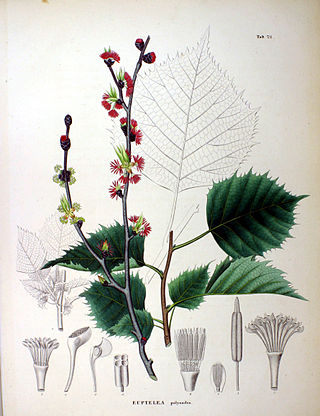
Euptelea is a genus of two species of flowering plants in the monogeneric family Eupteleaceae. The genus is found from Assam east through China to Japan, and consists of shrubs or small trees:

Berberidopsidaceae is a family of flowering plants. Such a family has only recently been recognized by more than a few taxonomists: the plants involved have often been treated as belonging to family Flacourtiaceae.
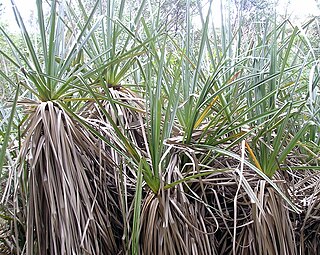
The Thurniaceae are a family of flowering plants composed of two genera with four species. The botanical name has been recognized by most taxonomists.

Dasypogonaceae is a family of flowering plants based on the type genus Dasypogon, one that has traditionally not been commonly recognized by taxonomists; the plants it contains were usually included in the family Xanthorrhoeaceae. If valid, Dasypogonaceae includes four genera with 16 species. The family is endemic to Australia. The best known representative is Kingia australis.

The Rapateaceae are a family of flowering plants. The botanical name has been recognized by most taxonomists.

The Ecdeiocoleaceae comprise a family of flowering plants with two genera and three species. The botanical name has rarely been recognized by taxonomists.

The Joinvilleaceae are a family of flowering plants with a single genus including four species. The APG II system, of 2003 assigns it to the order Poales in the clade commelinids in the monocots. The family consists of one genus with four currently accepted species, distributed from the Malay Peninsula to the Caroline Islands and high islands in the Pacific Ocean. It is evolutionarily significant as a relictual group closely related to grasses. They closely resemble large grass plants, in both general appearance and microanatomy, but possess fleshy fruits.
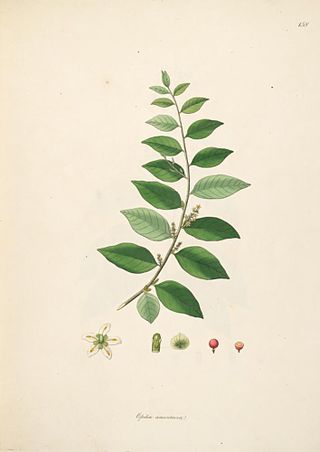
Opiliaceae is a family of flowering plants comprising 11 genera and 33 known species. It consists of tropical woody plants. Several genera contain parasitic species. The biggest genus, in number of species and in stature of the individual plants, is Agonandra, the only American genus.
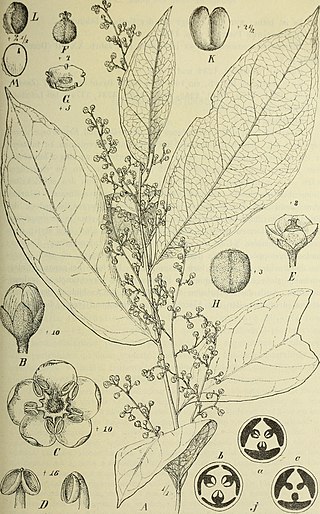
Centroplacaceae is a family of flowering plants in the order Malpighiales and is recognized by the APG III system of classification. The family comprises two genera: Bhesa, which was formerly recognized in the Celastraceae, and Centroplacus, which was formerly recognized in the Euphorbiaceae, together comprising six species. The Angiosperm Phylogeny Group determined that based on previous phylogenetic analysis, these two genera formed an isolated clade and recognition of the family was "reasonable."




















